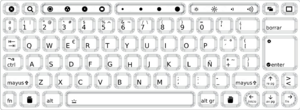Spanish language
| Castilian, Spanish Castellano, Español | ||
|---|---|---|
| Speakers | ~ 420,000,000 | |
| Countries | Andorra, Argentina, Belize, Bolivia, Chile, Colombia, Costa Rica, Cuba, Dominican Republic, Ecuador, El Salvador, Equatorial Guinea, España, Guatemala, Honduras, México, Morocco, Nicaragua, Panamá, Paraguay, Perú, Philippines, Puerto Rico, Trinidad & Tobago, Uruguay, USA, Venezuela | |
| Status | official | |
| Unicode | Latin-1 Block | |
| Direction | lrtb | |
| Alphabet | Latin (Spanish variant) ABCDEFGHIJKLMNÑOPQRSTUVWXYZ abcdefghijklmnñopqrstuvwxyz ÁÉÍÓÚÜ áéíóúü ¿¡!? | |
| ISO 639-1: | es | |
| ISO 639-2: | spa | |
| ISO/FDIS 639-3: | spa | |
Spanish or Castilian, the official language of Spain and most of Latin America, is written in the Latin alphabet with several accented letters, all of which are included in the Latin-1 block of Unicode.
Spanish (español) and Castilian (castellano) terms are both used and correct "Names given to the Spanish language". Association of Spanish Language Academies prefer "spanish" form.
l10n
- Character sets
- Unicode supported.
- Script layout
- is left-to-right, top-to-bottom. Fully supported by Pango the layout engine chosen.
- Fonts
- Most (all?) Latin 1 fonts support Spanish as is. In particular the one chosen by HIG-Text and Fonts (DejaVu LGS Sans).
- Keyboard
- OLPC_Spanish_Keyboard fully supports the language, although considerations should be taken regarding countries where more than one language is used. Example:
- Aymara
- Argentina, Bolivia, Chile, Perú OLPC Spanish keyboard is fine for Aymara Yamaplos 05:20, 7 June 2008 (EDT)
- Guarani
- Argentina, Bolivia, Brazil, & Paraguay
- Mapudungun
- Argentina & Chile
- Quechua
- Argentina, Bolivia, Chile, Colombia, Ecuador and Perú.
- Input methods
- except for 'standard' keyboard and touchpad would suffice for general use, although special considerations would be needed for physical dissabilities.
- Speech synthesis
- is a very locally-sensitive issue, not only at national levels, but also regional (regardless of any political structure). Widespread existance of regional accents and intonations, together with the use of local terminology (be it from native or co-existing languages, and locally accepted barbarisms) may lead to a series of issues when deploying.
- Although there exists a 'neutral spoken spanish' (widely used for dubbing TV & movies), linguistic 'minefields' do exist between regions.
- Music and sound samples
- is probably more appropriate at a country level, or better yet, provincial/state level in order to avoid predominance of the 'cultural' bias.
- Dictionaries, Spelling Checkers, Thesaurus
- are very much developed in Spanish, although not necessarily tuned for regional use. Of particular interest to Spanish is a working grammar checker given the level of words that differ only in an accented vowel, or differences in letters with little phonetical differentiation in everyday use: caso, casó, cazo, cazó (aprox: case/marry, married, hunt, hunted)
- aspell
- Spanish is treated as a single language unit, without regional/national divisions. Code:es Name: Spanish Script: Latin Available: 0.50 Status: Incomplete
- mozilla
- Makes / has the following subdivisions: Mexico, and Spain
- abiword
- Divides Spanish into the following national dictionaries: Argentina, Bolivia, Chile, Colombia, Costa Rica, Dominican Republic, Ecuador, El Salvador, Guatemala, Honduras, Mexico, Nicaragua, Panama, Paraguay, Peru, Puerto Rico, Spain, Uruguay, and Venezuela.
- OpenOffice
- presents Spanish as the Spain et al, or Mexico. It does offer hyphenation support.
- Character recognition
- This article is a stub. You can help the OLPC project by expanding it.
Alphabet
ABCDEFGHIJKLMNÑOPQRSTUVWXYZ abcdefghijklmnñopqrstuvwxyz
Some years ago, the Real Academia Española determined that the special 'composed' characters such as ch, ll, rr (which except for the double r, were all considered characters—ie: a, b, c, ch, d...) were 'discarded' and standardized into just a simple sequenciation. For further information you can see the wikipedia's article.
Special characters
- Accented characters
- ÁÉÍÓÚÜÑ
áéíóúüñ - Punctuation
- ¿¡
Formats
- Date
- Traditionally, dates are in the DD/MM/YY
- Numbers
- For Spain use the -9.999,99 format (period for thousands and coma for decimal, prefix sign). For Mexico use -9,999.99 format (coma for thousands and period for decimal, prefix sign). For other Latinamerican countries: [please complete]
Population
24,600 Andorra (1986)
33,000,000 Argentina official (1995)
80,477 Belize (1991 census)
3,483,700 Bolivia official + (1995)
13,800,000 Chile official (1995)
34,000,000 Colombia official (1995)
3,300,000 Costa Rica official (1995)
10,000,000 Cuba official (1995)
6,886,000 Dominican Republic official (1995)
9,500,000 Ecuador official (1995)
5,900,000 El Salvador official (1995)
11,500 Equatorial Guinea official (1993 Johnstone)
4,673,000 Guatemala official (1995)
5,600,000 Honduras official (1996)
86,211,000 Mexico official (1995)
20,000 Morocco (1993 Johnstone)
4,347,000 Nicaragua official (1995)
2,100,000 Panama official (1995)
186,880 Paraguay official (2000 WCD) 4,600,000 more likely
20,000,000 Peru official + (1995)
2,658 Philippines (1990 census)
3,437,120 Puerto Rico official (1996)
44,708,964 Spain official + (2006)
4,100 Trinidad and Tobago (2004)
3,000,000 Uruguay official (1995)
22,400,000 USA (1990 census)
21,480,000 Venezuela official (1995)
================================
343,970,119 TOTAL 348,570,119 TOTAL
Source: Ethnologue
Note that population data is generally at least 10 years old.
